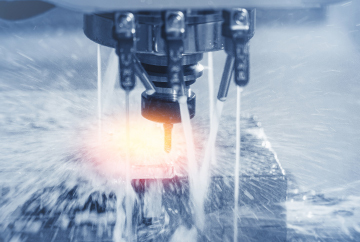Overview
In machinery manufacturing, the digital maturity of a shop floor can significantly impact the profit margins and revenues generated by a business. With the Industry 4.0 revolution well underway now, connected factories have become the top priority for global manufacturers. The technology for smart factories is now readily available, and plants of the future have become viable for manufacturers now.
Our client, a leading machinery and components manufacturer, was facing challenges like low asset utilization and uptime, high production costs, and ineffective maintenance outcomes. With large-scale operations spanning 10+ countries across globe, the client saw a significant opportunity in maximizing plant efficiency and uptime and optimizing production costs.
To this end, they sought a complete digital transformation of their machinery manufacturing plants and engaged Birlasoft to develop and implement a connected factory solution. Birlasoft employed its deep expertise in Industry 4.0 solutions and delivered a connected factory solution which helped reduce asset downtime and maintenance costs. See the details of the engagement and solution delivery below.
The Challenge
#1. Low asset utilization due to sub-optimal asset availability impacting production
In manufacturing, asset utilization directly impacts the revenue of the business per dollar invested in an asset. Since manufacturing is an asset-intensive industry, improving asset utilization is essential to enhance production metrics, plant capacity, and ultimately, revenues.
Low asset utilization is typically caused by poor asset availability and puts manufacturers at a competitive disadvantage. Ineffective maintenance practices, suboptimal production run scheduling, and failure to maintain aging assets on time are typically the root causes of low asset utilization.
Our client sought to improve asset uptime and availability, which would enable them to maximize utilization of the plant machinery and achieve a competitive advantage in global markets.
#2. Unexpected failures leading to unplanned downtime of critical assets
Legacy maintenance practices entail carrying out maintenance routines and repairs at fixed intervals. However, such practices fail to account for aging assets, which break down more frequently than new ones, and for unique production environment parameters, which can cause assets to malfunction erratically.
Unplanned downtime can prove very expensive for manufacturers. Breakdown of critical assets can cost as much as $260,000/hr. More importantly, eliminating unplanned downtime is not possible with legacy maintenance strategies like preemptive or reactive maintenance.
Our client wanted to maximize asset availability and uptime, which required them to mitigate unplanned downtime. For this, they sought to build a connected plant of the future, which could predict upcoming failures. This would enable them to conduct maintenance activities before critical assets broke down.
#3. Lack of control and predictability in production leading to high costs
Lack of complete control and predictability in plant operations has a direct bearing on production costs. For example, unplanned downtime can increase the cost of repairs and necessitate overtime for plant workers. Moreover, to meet production demands, organizations typically compensate by running multiple shifts, expediting shipments, and maintaining excess inventory. All these factors raise the production costs, thereby eroding the profit margins.
Our client sought to achieve better control and visibility into the production processes. This would enable them to optimize the production costs and manufacture machinery and consistent cost of production, which in turn, would increase the overall profits.
#4. Lack of visibility into plant assets and opportunities for preventive maintenance
Some machines in plants can be visually inspected for malfunction – for instance, conveyor belt slippage can be observed upon inspection, and appropriate maintenance procedures can then be carried out. However, such interventions are neither viable nor cost-effective on a plant-wide scale.
To spot the weak links in a manufacturing plant, it is necessary to have real-time visibility into all assets. Tracking key metrics and vibration signals of key equipment can help spot suboptimal functions and opportunities for predictive maintenance. Our client wanted to build this visibility into their manufacturing plants through a big data platform. This would help them spot opportunities for preventive maintenance, and mitigate the root cause of suboptimal performance in machines at a plant-wide level.
Birlasoft Solution
Birlasoft helped the client overcome these challenges by building a smart plant of the future through its proprietary connected factory solution and big data solutions and accelerators. See the highlights of the solution below.
#1. Big data platform to manage real-time data and build plant-wide visibility
Smart factories of the future make use of sensors that capture data points such as pressure, temperature, vibration, and acoustic signals associated with critical assets. This data is then streamed to a big data management platform to build real-time visibility into key assets. With this data, it is possible to infer the health of each asset in real-time.
Using the Birlasoft Big Data Platform, we were able to support high velocity, high volume data machine analytics for our client. Sensor data from the plant is ingested, transformed, and loaded onto the big data platform, which supports the connected factory solution architecture.
#2. Predictive maintenance expert system to mitigate unplanned downtime of spinning machines
Unplanned downtime can be effectively eliminated by making use of predictive analytics systems, which compare the real-time data of machines in production against the signals that correspond to their normal function. With such systems, it is possible to spot a failure well in advance of its actual occurrence. This helps plant operators carry out maintenance activities at an optimal point before the predicted point of failure, and avoid unexpected downtime.
In the textile industry, spinning machines are critical piece of equipment that transform raw material into workable threads and yarns. In other words, they are the key to successful mass production in the cotton industry. Our predictive maintenance expert system targeted spinning machines, and it helped the client predict upcoming failures with a high degree of accuracy. This helped them achieve maximal availability for spinning machines, which improved asset utilization and maximized production.
#3. Conditional and correlational alarm generation for continuous machine monitoring
The real-time data captured from sensors in a connected plant cannot be used as is by humans to monitor asset conditions. When the plant is functioning optimally, scanning the data streams for signs of anomaly is counterproductive and time-consuming. That’s why intelligent alarm systems are an essential feature of connected factories of the future.
Birlasoft developed conditional alarms that could notify plant operators of anomalous events in real time, thereby helping them monitor machine status effectively. Moreover, to suppress noise and false alerts, Birlasoft developed contextual alarms in addition to correlational alarm capabilities, which could identify the root cause of a failure or anomalous behavior within the system. These capabilities helped the client maximize the productivity of skilled technicians, and improve the overall equipment efficiency (OEE) across the plant.
#4. Abnormal behavior detection and known fault prediction to drive predictive maintenance
Not all sensor data captured in smart factories can be read by humans. For instance, vibration data or acoustic signals of various machines will typically sound similar to a human. However, the acoustic signature associated with the normal functioning of a machine is different from when it is about to experience a failure. Subtle changes in the signature can help detect anomalous behavior of a machine, and this can be used to predict known faults well in advance.
Birlasoft devised a capability to detect anomalous behavior of assets by analyzing sensor data ingested in the big data platform. Anomalous behavior detection went hand-in-hand with the fault prediction capability, which helped the client’s plant operation teams spot a known failure weeks before it would actually happen. These features were crucial to activating a predictive maintenance strategy at the client organization.
#5. Maintenance planning and ticket generation to support maintenance workflows
Finally, the Birlasoft team created a knowledge base to support standardized maintenance workflows and integrated the Connected Factory solution to support maintenance workflows. The integrated solution helped the plant operators plan maintenance schedules more effectively.
The integrated solution also enabled automated ticket generation for issuing maintenance work orders. In conjunction with automated abnormal detection and fault prediction, the integrated maintenance planning system enabled the client to conduct maintenance workflows with high efficiency and in a targeted fashion, bringing down the overall costs of maintenance.
Key Business Benefits/Impact
The Connected Factory solution is now helping the client maximize their RoI on their plant assets, and operate their manufacturing facilities with greater visibility and precision at lower costs. Here are the key benefits that Birlasoft delivered to the client by transforming its facilities into plants of the future:
1. Complete visibility into machine health through continuous monitoring
By streaming sensor data to the big data platform, Birlasoft was able to build real-time visibility into machine health across the plant. To this end, it developed a Machine Dashboard, which helps plant operators visualize key data points associated with a machine – for instance, its health score, maintenance status, production shift schedules, and recent alarms associated with the machine.
2. Faster availability of operational data to support responsive plant control
The big data architecture deployed by Birlasoft made operational data available upto 50% faster under the given circumstances, which enabled prompt decisioning in response to evolving plant conditions. Faster availability of operational data also helped detect erratic machine behavior faster, which in turn enabled preemptive maintenance and repair activities.
3. Reduction in asset downtime through predictive maintenance
The full spectrum of interventions delivered through the digitization of the client’s manufacturing plants resulted in approximately 30% reduction in asset downtime and near-zero unplanned downtime. This brought a greater degree of predictability into the production process and helped maximize asset utilization.
4. Reduction in overall maintenance costs with a connected factory solution
By mitigating unexpected failures and optimizing the maintenance frequency through predictive maintenance, we were able to achieve upto 20% reduction in maintenance costs for the client. Moreover, predictive maintenance also improved the RoI on existing assets, while supporting more reliable production at lower costs.
5. Automated anomalous behavior detection and alarm generation
By automating anomalous behavior detection of plant assets, the Connected Factory solution enabled continuous monitoring of the plant while eliminating the need for human oversight. Moreover, the alarm generation capabilities ensure that the plant operators get notified of critical events immediately.
6. More efficient plant maintenance workflows through an integrated solution
Finally, the integrated solution has helped the clients increase their maintenance productivity. Automated ticket generation and work order creation enable the client to drive seamless maintenance workflows, thereby enabling improved plant outcomes within the guardrails of standard procedures.


